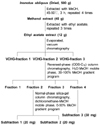Abstract
Figures and Tables
 | Fig. 2Morphology of antitumor activity of subfraction 1 from Inonotus obliquus on mice bearing Sarcoma-180 cells (S-180). The Sarcoma-180 cells were implanted subcutaneously in the left groins of mice. After 24 h, the mice were fed normal chow supplemented with water (S-180+water, control), 0.1 mg subfractions 1 per mouse per day (S-180+subfraction 1A) or 0.2 mg subfractions 1 per mouse per day (S-180+subfraction 1B) for 20 days. The mice were fed normal chow for seven days after the last oral administration of subfractions. Solid tumors were removed on the 27th day after cancer cell implantation. |
Table 1

Data are presented as means ± SD of four experiments.
Values with different superscripted letters (a-j) within the same column are significantly different (P < 0.05) as determined by Duncan's multiple-range test.
1) A549, AGS, MCF-7 and HeLa were lung carcinoma A549 cells, breast adenocarcinoma MCF-7 cells, stomach adenocarcinoma AGS cells and cervical adenocarcinoma HeLa cells, respectively.
2) Subfraction
Table 2

Values are means ± SD of six mice.
Values with different superscripted letters (a-e) within the same row are significantly different (P < 0.05) as determined by Duncan's multiple-range test. The Sarcoma-180 cells were implanted subcutaneously in the left groins of mice. After 24 h, the mice were fed normal chow supplemented with water (S-180+water, control), 0.1 mg of subfraction 1 per mouse per day (S-180+subfraction 1A), 0.2 mg of subfraction 1 per mouse per day (S-180+subfraction 1B), 0.1 mg of subfraction 2 per mouse per day (S-180+subfraction 2A), 0.2 mg of subfraction 2 per mouse per day (S-180+subfraction 2B), 0.1 mg of subfraction 3 per mouse per day (S-180+subfraction 3A) or 0.2 mg of subfraction 3 per mouse per day (S-180+subfraction 3B) for 20 days. The mice were fed normal chow for seven days after the last oral administration of subfractions. Solid tumors were removed on the 27th day after cancer cell implantation.




 PDF
PDF ePub
ePub Citation
Citation Print
Print



 XML Download
XML Download